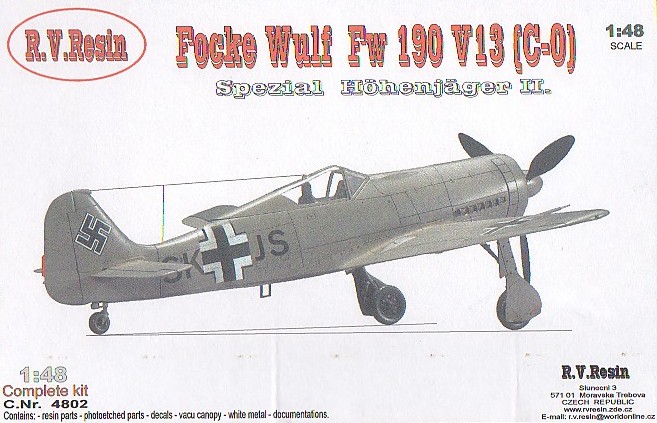|
Focke-Wulf Fw 190 V13
(C-0)

R.V. Resin
S
u m m a r y
|
| Description and Catalogue Number: |
R.V.Resin Focke-Wulf Fw 190 V13
(C-0); Kit#48002 |
| Scale: |
1/48 |
| Contents and Media: |
See text below |
| Price: |
Approx. USD$40 (availability details
at bottom of page) |
| Review Type: |
FirstLook |
| Advantages: |
Nice detail, thin decals, good use
of photo-etch and metal |
| Disadvantages: |
Resin parts spoiled by pitting (see
footnote at bottom of review concerning quality control). |
| Recommendation: |
Recommended |
Reviewed by Robert Baumgartner

HyperScale is proudly supported by Squadron.com
The Fw 190 V13 was the first attempt to solve the
high altitude performance problem that was being experienced by the Fw
190A series.
The 29th Fw 190A-0 airframe was chosen to
be fitted with a GM 1 system (nitrous oxide injection) to enable the
engine to perform beyond its normal operating altitude.
This proved disappointing due to the extra weight of
the equipment needed as well as problems in lagging the pipelines.
Having failed using the radial air-cooled BMW 801
engine, a liquid-cooled inline DB 603 power plant was substituted. The
first B series prototype had now become the first C series prototype. This
latter machine is the subject of this kit.
It is obvious that a lot of thought and effort has
gone into this product.The packaging is the best that you will come across
in a kit of this type.
All of the pieces are sealed in their own
compartments within a clear plastic bag. Even the photo-etched fret,
decals, canopy and white metal parts get this treatment.
As stated on the box, this is indeed a complete kit.
There are twenty-four resin pieces and it is evident
that the well-engineered Tamiya kit was used as a basis for some of these
items.
Click the
thumbnails below to view larger images:
The major components are enhanced with some fine
rivet detail and contour changes where appropriate.
The lower wing is moulded in one piece but the
correct amount of dihedral was found to be lacking. This can be solved by
gently bending the part in hot water and then applying cold water to allow
it to set.
The fuselage halves are superb with the grafted DB
603A nose easily matching the quality of the rest of the kit. Despite
their length, there was no evidence of warping in either of these parts.
Resin is also used for the interior with the cockpit
tub, seat, control column, instruments panels and wheel wells all being
nicely detailed.
Other items in this medium include the propeller
blades, spinner, exhaust, wheels, cowling and wheel well covers.
Closer examination reveals that all but one of the
resin pieces is heavily pitted over its entire surface.
Sadly there is a myriad of them and they are larger
and deeper than the rivet detail. Some are even as wide as the panel
lines.
Hopefully my example was an isolated case as
eradicating them would remove all of the surface detail.
(Editor's Note - I have
two of RV Resins' full resin kits and several conversions. I have just
re-examined mine, and they do not examine any pitting or other serious
surface or casting problems. This is likely to be an isolated quality
problem)
The lovely little photo-etched set gives all of the
usual items. These being the seatbelts, rudder pedals, radiator grills,
footstep, pilot armour and cockpit decking.
A single vacformed canopy is provided as a one-piece
affair. Thus care will be needed if this is to be separated to have it in
the open position.
Five white metal parts complete the undercarriage and
as these are based on the Tamiya kit, some may feel that the main legs
have to be lengthened.
Naturally decals are supplied for just the one
version and these are gems. They were in perfect register and are printed
with very thin carrier film.
R.V.Resin continues with their agenda to produce
examples of the many “test beds” used during the Fw190 program.
Although the kit itself is an outstanding piece of
work, a bit more attention needs to be directed at the quality control.
Recommended
Thanks to Radek from R.V. Resin for the review sample
Footnote:
David Cooper from DMC Models has advised that he is
willing to check all the resin parts in RV Resin kits and accessories that
he sells for defects, with the permission of the customer. The parts are
sealed in their plastic bags, so the prior authority of the customer will
be required as the bag will not be re-sealed per the original packaging.
However, the customer will be assured that the resin parts are defect
free.
In North America, R.V.
Resins Products are available from
David Cooper at DMC Models; or from
North American Hobbies website;
or elsewhere in the world, direct from
R.V. Resin at their website
Review and Images Copyright © 2003 by
Robert Baumgartner
Page Created 17 September, 2003
Last updated 19 September, 2003
Back to HyperScale Main Page
Back to Reviews Page
|
Home | What's
New | Features
| Gallery |
Reviews | Reference
| Forum
| Search